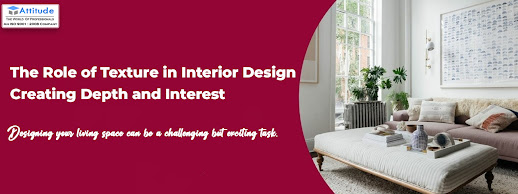The Role of Texture in Interior Design: Creating Depth and Interest
Introduction:
Designing your living space
can be a challenging but exciting task. You can incorporate a range of elements
like colors, furniture, and lighting to create a unique ambiance that reflects
your personality and style. But have you ever considered the power of texture
in interior design? In this blog post, we'll explore how texture influences interior
design trends and its role in creating depth and interest in your living
space.
The Importance of Texture:
Texture is a crucial element
of interior design and plays a vital role in shaping the overall look and feel
of a room. It offers a sensory and visual experience that can create depth,
contrast, and interest. Interior designers use texture to create a multi-dimensional
effect that can transform an ordinary space into an extraordinary one.
Creating Depth:
Texture can add depth to a
room by introducing a sense of dimension and layering. By combining different
textures, you can create a visual effect that adds intrigue to your interior.
For example, pairing a plush, textured rug with smooth, glass surfaces or sleek
metal furniture can make your space feel more inviting and visually engaging.
Lighting and Texture:
Texture and lighting go hand
in hand when it comes to interior design. Proper lighting can accentuate
different textures, making them more pronounced and interesting. You can use
soft, warm lighting to enhance the coziness of a textured, upholstered couch or
bright, directional lighting to highlight the unique texture of a stone feature
wall. By thoughtfully combining texture and lighting, you can take your design
to the next level.
Interior Design Trends and
Texture:
Texture is an ever-evolving
aspect of interior design that reflects current trends. The trend of bringing
the outdoors in has led to an increased use of natural textures such as wood,
stone, and greenery in interior spaces. You can mix these elements with
contemporary lighting design ideas to create a harmonious blend of old and new,
making your space feel fresh and welcoming.
Conclusion:
Texture is a powerful tool
that can define the mood, style, and personality of your living space. While
furniture and lighting are important, never underestimate the transformative
power of texture. By understanding how texture can create depth and interest,
you can create an interior design that truly captivates the senses. So, as you
embark on your next design project, remember to incorporate a variety of
textures and explore innovative lighting design ideas to craft a space that truly
captivates the senses.
Your choice of textures and
lighting can define the mood, style, and personality of your space. Be bold,
experiment, and let texture be the guiding star in your interior design
journey.




Comments
Post a Comment